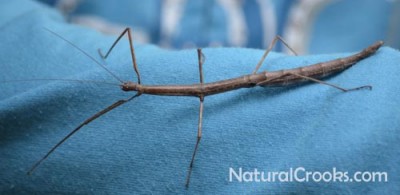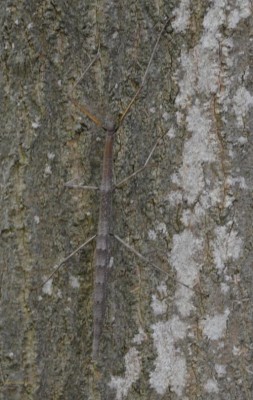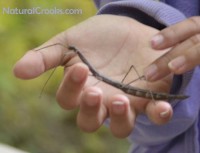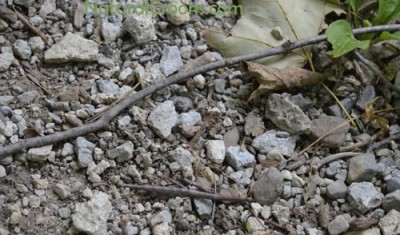About 9 cm long, bark brown, very long shapely legs, quiet, enjoys outdoors. Seeks male for friendship, possible relationship.
 Northern Walkingstick Steps Out
Northern Walkingstick Steps Out
What kind of insect is it?
The insect in these photos is a Northern Walkingstick or Diapheromera femorata as it calls itself when it’s going to a really fancy party.
So I was looking at this twig when it started to walk away
How good is the Northern Walkingsticks’ camouflage? Pretty decent, I’d say. If you look at the photos on this page, you’ll see that against the grey of the tree bark and the pebbles on the ground the insect blends in well.
 What I can’t show in these photos is their behaviour. When the walkingstick was encouraged to walk back onto the tree trunk, it did so willingly. Then it stayed there, swaying gently from side to side for several minutes. It looked like a twig gently swaying in the breeze.
What I can’t show in these photos is their behaviour. When the walkingstick was encouraged to walk back onto the tree trunk, it did so willingly. Then it stayed there, swaying gently from side to side for several minutes. It looked like a twig gently swaying in the breeze.
Is it a male or a female walkingstick?
Really ancient readers may remember a magazine model called Twiggy. She was a girl, I think. So I wondered whether the walkingstick we found was a girl or boy. Like with Twiggy, it’s a little hard to tell.
Both sexes of Northern Walkingsticks look almost the same. The pinchy-looking clasper at the tail end is not a giveaway, unfortunately. Apparently, adult males are generally brown and females are more of a greenish-brown. Males generally are smaller (75mm, 3 inches) than females (95mm, 3.75 inches).
The University of Michigan also says that “the femurs of males tend to be banded, their seventh abdominal segment is longer than their ninth and they feature cerci that lack spines.”
This is all very useful information, but not for me. Which of the 3 legs on each side is the femur? Or do they mean all of the legs? Where does the abdomen segment counting start, from the head-end or tail-end? For that matter, where does the thorax end and the abdomen start? I don’t really even want to know what a cerci is.
Asking the Pros
So I decided to ask the pros at BugGuide.Net about my find. David J. Ferguson kindly replied that this was a female Northern Walkingstick. He said, “The males tend to have a stronger pattern, more often have green coloring, are more slender in shape (but legs are thicker), and the appendages near the end of the abdomen are different.”
What Do They Eat?
Walkingsticks are herbivores. That doesn’t mean they only eat parsley, sage, rosemary and thyme. It means they eat plant material, not other insects or animals.
Northern Walkingsticks like to eat oak leaves. They’ll also eat black cherry. Further south where they are more common, hazelnut trees play host, too. They have been spotted eating sweetfern, strawberry and blueberry plants and beaked hazel.
They tend to eat almost the entire leaf, leaving only a skeleton of veins. Some studies have shown that they eat and are active mostly at night.
People keeping them in captivity report they will eat blackberry leaves, rose leaves, apple, plum and currant leaves. Some owners have fed them the green part of the leaves of romaine lettuce.
 Will They Bite Me?
Will They Bite Me?
While it’s possible they could bite a human, I’ve handled several over the years and never been bitten. Many people keep Northern Walkingsticks as temporary pets in a terrarium and also don’t seem to report being bitten. When handling any wild creature, however, use caution.
Will I Bite Them?
Well, technically they should be edible, but I wouldn’t try one! Birds, however, do eat them, and in large numbers. When there is a walkingstick baby boom, the robins and other insect-eating birds tend to have more babies, too. So in Canada while Northern Walkingsticks are classified as a pest, they are not life-threatening to the trees.
The eggs and insects are also eaten by small mammals (think voles, mice and squirrels) and other insects like praying manti. In their US range, they are also eaten by lizards.
How Can I Find a Walkingstick?
Actually, you’re more likely to find one by accident than by design. The adult walkingsticks spend most of their lives at the tops of trees.
One of my child’s friends found this Northern Walkingstick clinging aimlessly to a boardwalk railing on a nature trail in Riverwood Park in Mississauga.
On this website from London Ontario, you can see some photos of a two-tone (green and brown) model found on a car. And in The Mystery of the Two Walkingstick Insects is another photo of a male.
Frankly, I think some of these ones found in odd places fell there.
 Why Don’t They Fall Out of the Trees More Often?
Why Don’t They Fall Out of the Trees More Often?
Apparently Northern Walkingsticks have both claws and sucker pads on their feet. So they can sturdy grip onto the real twigs up there.
I Live in Newfoundland and I’ve Never Found a Walkingstick
According to the Royal Alberta Museum, these Northern Walkingsticks are only found in southern Ontario and Québec. Another website says they are in southern Manitoba as well. (Don’t ask why they are called “Northern” if they are only found in “Southern” Canada. I suspect the Americans are involved.) So the chances of finding one in the other provinces are small.
Partly this may be because they do not seem to eat coniferous tree needles. If that’s true, it would limit their spread through provinces that are dominated by spruces and pines.
Raindrops, Wait, No!, Egg Drops! Keep Falling on my Head
Apparently, the Moms don’t even climb down to lay their eggs. Instead, they drop them, one at a time, from the tree tops. The eggs land in the dirt below. If they don’t get eaten, stepped on, or drown, they hatch the following spring. The babies, called nymphs, then climb the nearest tall object looking for food.
The peak egg laying time is mid-September, according to the University of Michigan. Hatching is most common in June and July. The eggs, apparently, resemble the seeds of legumes. One website says they look like black and white beans.
Are Walkingsticks Dangerous?
One walkingstick of the tropical species found in Florida and parts of the southern USA can be dangerous. As a defensive mechanism, that type of insect can spray a liquid up to two feet backwards. The liquid can cause eye damage in dogs and humans. So for any of us northerners vacationing in the sunny south, we should be more cautious approaching walkingsticks than at home.
Still Curious?
For more information on the Northern Walkingstick, check out
http://animaldiversity.ummz.umich.edu/accounts/Diapheromera_femorata/
Join In
Have you found a walkingstick recently? Or had an egg land on you? Please share your experiences with a comment.

I found one on my deck this morning and the poor thing is missing 3 legs! :( So after doing research and determining that it could regrow them through molting, and learning how to care for it, I decided it had a better chance of survival if I bought a terrarium and brought it in our home to care for it. Now just trying to determine if it is a he or a she, so we name it appropriately. I’m not quite sure, but I believe one of the ones I saw the other night, might have been one of the Giant Walking Sticks, as just its body was approximately 6 inches long. I’ve seen over a dozen just in the last week, but I do have a 3 huge oak trees, with one right in front of the home and a antique rose Bush next to the deck as well. I Love getting to see nature all of the time! :) Thank you for the wonderful information!
Very interesting!
I don’t know how to tell the one sex from the other, but if you were interested, you might want to post a request for information on BugGuide.net and see if anyone can help. They do more with identifying the species usually than the sex, but they might have some suggestions.
Thanks so much for sharing!
I found one this morning on our front deck in Sandycove acres. I haven’t seen one since I was a child in Springbrook. That was many years ago.
How cool! Thanks for sharing your sighting!